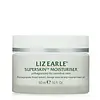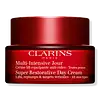What's inside
What's inside
 Key Ingredients
Key Ingredients

 Benefits
Benefits

 Concerns
Concerns

 Ingredients Side-by-side
Ingredients Side-by-side

Water
Skin ConditioningGlycerin
HumectantEthylhexyl Stearate
EmollientVaccinium Macrocarpon Seed Oil
Skin ConditioningDiheptyl Succinate
EmollientRosa Rubiginosa Seed Oil
EmollientBorago Officinalis Seed Oil
EmollientCetearyl Alcohol
EmollientPentaerythrityl Distearate
EmulsifyingGlyceryl Stearate
EmollientButyrospermum Parkii Butter
Skin ConditioningPunica Granatum Flower Extract
Skin ConditioningMaltodextrin
AbsorbentPhenoxyethanol
PreservativeTocopherol
AntioxidantCitronellyl Methylcrotonate
MaskingSodium Polyacrylate
AbsorbentSodium Stearoyl Glutamate
CleansingCapryloyl Glycerin/Sebacic Acid Copolymer
Skin ConditioningEthylhexylglycerin
Skin ConditioningBenzoic Acid
MaskingXanthan Gum
EmulsifyingDehydroacetic Acid
PreservativeSodium Ascorbyl Phosphate
AntioxidantCitric Acid
BufferingWater, Glycerin, Ethylhexyl Stearate, Vaccinium Macrocarpon Seed Oil, Diheptyl Succinate, Rosa Rubiginosa Seed Oil, Borago Officinalis Seed Oil, Cetearyl Alcohol, Pentaerythrityl Distearate, Glyceryl Stearate, Butyrospermum Parkii Butter, Punica Granatum Flower Extract, Maltodextrin, Phenoxyethanol, Tocopherol, Citronellyl Methylcrotonate, Sodium Polyacrylate, Sodium Stearoyl Glutamate, Capryloyl Glycerin/Sebacic Acid Copolymer, Ethylhexylglycerin, Benzoic Acid, Xanthan Gum, Dehydroacetic Acid, Sodium Ascorbyl Phosphate, Citric Acid
Water
Skin ConditioningCaprylic/Capric Triglyceride
MaskingCetearyl Alcohol
EmollientSqualane
EmollientPentylene Glycol
Skin ConditioningGlycerin
HumectantHydrogenated Coco-Glycerides
EmollientAscorbyl Glucoside
AntioxidantButyrospermum Parkii Butter
Skin ConditioningGlyceryl Stearate
EmollientPEG-100 Stearate
Cetearyl Glucoside
EmulsifyingDimethicone
EmollientHydroxyethyl Acrylate/Sodium Acryloyldimethyl Taurate Copolymer
Emulsion StabilisingButylene Glycol
HumectantCarbomer
Emulsion StabilisingCaprylyl Glycol
EmollientSodium Hydroxide
BufferingSucrose Palmitate
EmollientXylitylglucoside
HumectantParfum
MaskingSodium Citrate
BufferingAnhydroxylitol
HumectantTocopheryl Acetate
AntioxidantCI 77891
Cosmetic ColorantSynthetic Fluorphlogopite
Dimethiconol
EmollientXylitol
HumectantGlyceryl Linoleate
EmollientDisodium EDTA
Polysorbate 60
EmulsifyingCitric Acid
BufferingSodium Lactate
BufferingSorbitan Isostearate
EmulsifyingGlucose
HumectantHarungana Madagascariensis Extract
Skin ConditioningMarrubium Vulgare Extract
Skin ConditioningPotassium Sorbate
PreservativePropanediol
SolventCoco-Glucoside
CleansingPectin
Emulsion StabilisingSodium Hyaluronate
HumectantBalanites Roxburghii Seed Oil
Skin ConditioningGuar Hydroxypropyltrimonium Chloride
Skin ConditioningPhenethyl Alcohol
MaskingFurcellaria Lumbricalis Extract
Skin ConditioningPancratium Maritimum Extract
BleachingUlex Europaeus Leaf/Root/Stem Extract
Skin ConditioningPalmitoyl Tripeptide-1
Skin ConditioningLapsana Communis Flower/Leaf/Stem Extract
Skin ConditioningMaris Sal
Skin ConditioningCI 14700
Cosmetic ColorantPalmitoyl Tetrapeptide-7
Skin ConditioningWater, Caprylic/Capric Triglyceride, Cetearyl Alcohol, Squalane, Pentylene Glycol, Glycerin, Hydrogenated Coco-Glycerides, Ascorbyl Glucoside, Butyrospermum Parkii Butter, Glyceryl Stearate, PEG-100 Stearate, Cetearyl Glucoside, Dimethicone, Hydroxyethyl Acrylate/Sodium Acryloyldimethyl Taurate Copolymer, Butylene Glycol, Carbomer, Caprylyl Glycol, Sodium Hydroxide, Sucrose Palmitate, Xylitylglucoside, Parfum, Sodium Citrate, Anhydroxylitol, Tocopheryl Acetate, CI 77891, Synthetic Fluorphlogopite, Dimethiconol, Xylitol, Glyceryl Linoleate, Disodium EDTA, Polysorbate 60, Citric Acid, Sodium Lactate, Sorbitan Isostearate, Glucose, Harungana Madagascariensis Extract, Marrubium Vulgare Extract, Potassium Sorbate, Propanediol, Coco-Glucoside, Pectin, Sodium Hyaluronate, Balanites Roxburghii Seed Oil, Guar Hydroxypropyltrimonium Chloride, Phenethyl Alcohol, Furcellaria Lumbricalis Extract, Pancratium Maritimum Extract, Ulex Europaeus Leaf/Root/Stem Extract, Palmitoyl Tripeptide-1, Lapsana Communis Flower/Leaf/Stem Extract, Maris Sal, CI 14700, Palmitoyl Tetrapeptide-7
Ingredients Explained
These ingredients are found in both products.
Ingredients higher up in an ingredient list are typically present in a larger amount.
This ingredient is also known as shea butter. It is an effective skin hydrator and emollient.
Emollients help soothe and soften your skin. It does this by creating a protective film on your skin. This barrier helps trap moisture and keeps your skin hydrated. Emollients may be effective at treating dry or itchy skin.
Shea butter is rich in antioxidants. Antioxidants help fight free-radicals, or molecules that may harm the body. It is also full of fatty acids including stearic acid and linoleic acid. These acids help replenish the skin and keep skin moisturized.
While Shea Butter has an SPF rating of about 3-4, it is not a sunscreen replacement.
Shea butter may not be fungal acne safe. We recommend speaking with a professional if you have any concerns.
Learn more about Butyrospermum Parkii ButterCetearyl alcohol is a mixture of two fatty alcohols: cetyl alcohol and stearyl alcohol. It is mainly used as an emulsifier. Emulsifiers help prevent the separation of oils and products. Due to its composition, it can also be used to thicken a product or help create foam.
Cetearyl alcohol is an emollient. Emollients help soothe and hydrate the skin by trapping moisture.
Studies show Cetearyl alcohol is non-toxic and non-irritating. The FDA allows products labeled "alcohol-free" to have fatty alcohols.
This ingredient is usually derived from plant oils such as palm, vegetable, or coconut oils. There is debate on whether this ingredient will cause acne.
Due to the fatty acid base, this ingredient may not be Malassezia folliculitis safe.
Learn more about Cetearyl AlcoholCitric Acid is an alpha hydroxy acid (AHA) naturally found in citrus fruits like oranges, lemons, and limes.
Like other AHAs, citric acid can exfoliate skin by breaking down the bonds that hold dead skin cells together. This helps reveal smoother and brighter skin underneath.
However, this exfoliating effect only happens at high concentrations (20%) which can be hard to find in cosmetic products.
Due to this, citric acid is usually included in small amounts as a pH adjuster. This helps keep products slightly more acidic and compatible with skin's natural pH.
In skincare formulas, citric acid can:
While it can provide some skin benefits, research shows lactic acid and glycolic acid are generally more effective and less irritating exfoliants.
Most citric acid used in skincare today is made by fermenting sugars (usually from molasses). This synthetic version is identical to the natural citrus form but easier to stabilize and use in formulations.
Read more about some other popular AHA's here:
Learn more about Citric AcidGlycerin is already naturally found in your skin. It helps moisturize and protect your skin.
A study from 2016 found glycerin to be more effective as a humectant than AHAs and hyaluronic acid.
As a humectant, it helps the skin stay hydrated by pulling moisture to your skin. The low molecular weight of glycerin allows it to pull moisture into the deeper layers of your skin.
Hydrated skin improves your skin barrier; Your skin barrier helps protect against irritants and bacteria.
Glycerin has also been found to have antimicrobial and antiviral properties. Due to these properties, glycerin is often used in wound and burn treatments.
In cosmetics, glycerin is usually derived from plants such as soybean or palm. However, it can also be sourced from animals, such as tallow or animal fat.
This ingredient is organic, colorless, odorless, and non-toxic.
Glycerin is the name for this ingredient in American English. British English uses Glycerol/Glycerine.
Learn more about GlycerinGlyceryl Stearate is a mix of glycerin and stearic acid.
It is used to stabilize the mixing of water and oil ingredients. By preventing these ingredients from separating, it can help elongate shelf life. It can also help thicken the product's texture.
As an emollient, it helps soften skin and supports barrier-replenishing ingredients.
In cosmetics, Glyceryl Stearate is often made from vegetable oils or synthetically produced.
This ingredient may not be fungal-acne safe
Fun fact: The human body also creates Glyceryl Stearate naturally.
Learn more about Glyceryl StearateWater. It's the most common cosmetic ingredient of all. You'll usually see it at the top of ingredient lists, meaning that it makes up the largest part of the product.
So why is it so popular? Water most often acts as a solvent - this means that it helps dissolve other ingredients into the formulation.
You'll also recognize water as that liquid we all need to stay alive. If you see this, drink a glass of water. Stay hydrated!
Learn more about Water